What Is Aquascaping? A Beginner’s Guide
Apr 17th 2025

Apr 17th 2025

Aquascaping is a fusion of art and the science of arrangement. Its layout processes can be compared to those of a photographer or painter, as they have the same principles. Color, texture, and structure are formed by carefully cultivating and arranging live plants, stone, wood, sand, and other natural materials.
It takes an artistic eye, manual dexterity, and knowledge of several species of plants and their growth systems under water. The battle with algae rapidly becomes an art. Controlling illumination, CO2 intake, water circulation, and water chemistry is a fine art form that aims to keep everything flourishing and harmonious.
Definition: Aquascape/ˈä-kwe-ˌskap/ n: an arrangement of underwater plant life and structures inside an aquarium imitating an underwater ecosystem.
In Japan, the late and great Takashi Amano invented and popularized aquascaping. As a nature photographer, his hobby turned into capturing slices of nature in glass aquariums. He incorporated many Japanese gardening concepts, including Wabi-sabi and Zen rock arrangements, into his plant layouts. He founded Aqua Design Amano Co., Ltd. in 1982, which supplied equipment for growing aquatic plants. His Nature Aquarium photo books, Glass no Naka no Daishizen, published in 1992, followed by Mizu-Shizen no Kaiki, were translated into seven languages.
His nature aquariums are renowned worldwide, and today, his legacy continues through Aqua Design Amano and the countless adoring fans who were and still are inspired by him. The most hardcore hobbyists compete in aquascaping competitions, which feature thousands of submissions from around the globe.
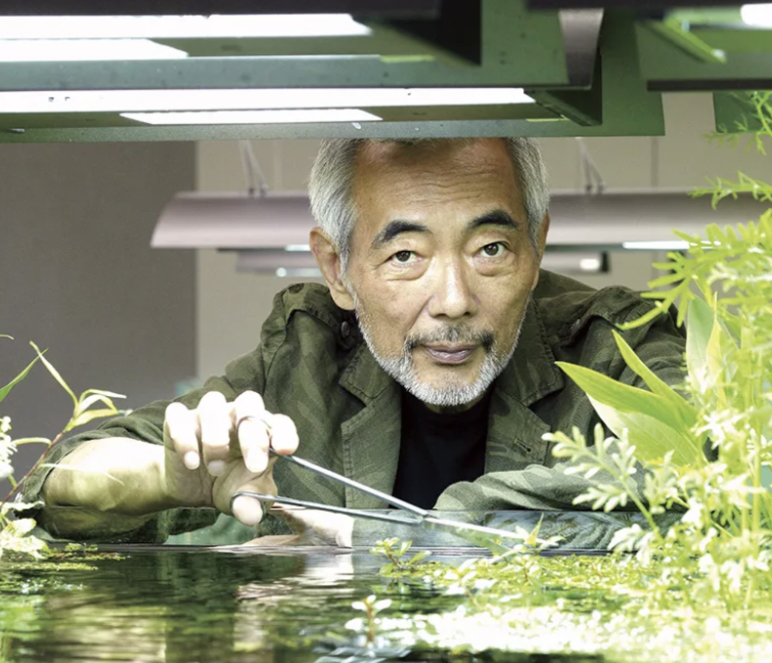 Takashi Amano, the nature aquarium legend.
Takashi Amano, the nature aquarium legend.
Styles That Inspire: Popular Aquascaping Layouts
Aquascaping is more than just arranging the plants and rocks in the tank; it is an art that transforms glass boxes into beautiful pieces of nature. Whether one prefers organized geometric shapes and minimalism or untamed overgrown jungles, every person can find a layout style that resonates with their sense of beauty.
In this blog, we will examine the most interesting ways aquarists build separate worlds, from traditional tried-and-true methods to innovative new takes on old ideas. Let’s discuss the styles that continue to inspire creativity in tanks of all sizes.
The Iwagumi aquascaping style is just a Japanese interpretation of nature where balance and tranquility are focal points. This is somewhat simplified compared to the works by aquascaping legend Takashi Amano. Breaking down his work, this style employs stones, ishi, as the focal feature of any given layout. He uses roughly three to five rocks where one, or the heaviest stone, is arranged (Oyaishi) and two others (Fukuishi and Soeishi) that balance the structure according to the Japanese design principle of asymmetrical odd numbers.
Every Iwagumi layout has minimal plant sources, usually capped with a single herbaceous plant like Glossostigma elatinoides or Hemianthus callitrichoides. Iwagumi aquarists prefer to use more merging and calm fish like Harlequin Rasboras or Cardinal Tetras to maintain stillness.
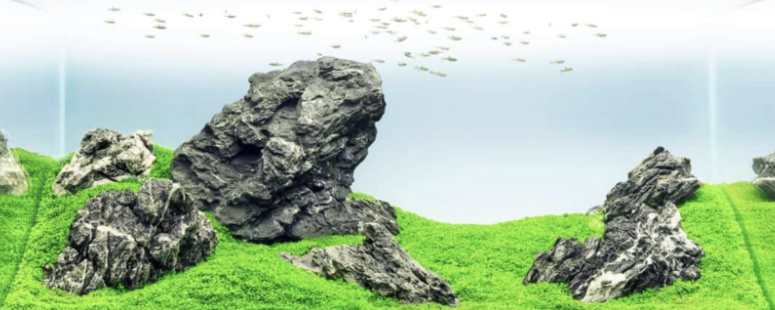 Iwagumi aquascape.
Iwagumi aquascape.
Takashi Amano also invented the Classic Nature Aquarium style, which is based on forests and river banks and takes inspiration from natural landscapes. This style blends driftwood, stones, aquatic plants, and the organic feel of nature into an aquarium that works as a miniature ecosystem.
The Nature Aquarium layout is more liberal with the different plant types than Iwagumi since it can contain stem plants, carpeting plants in the foreground, and epiphytes such as anubias and Java Fern. The flow of what is seen often moves towards the other one that follows the “golden ratio” or other natural compositional methods.
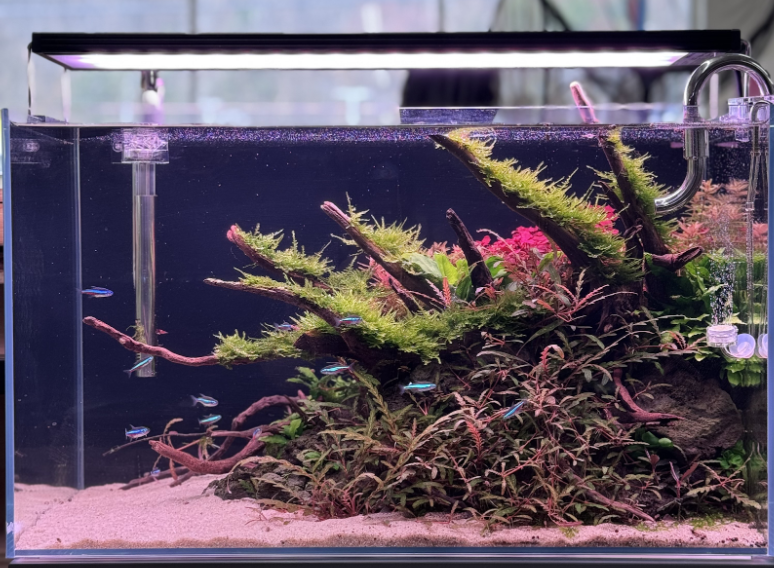 Classic, triangle-shaped nature aquarium layout is available at our Green Brook, NJ, location.
Classic, triangle-shaped nature aquarium layout is available at our Green Brook, NJ, location.
The Brazilian aquascaping style stands out for its unique high-intensity structural color and plant diversity. It has its roots in Brazil’s profound aquascaping community, integrating attributes of Dutch and Nature Aquarium styles with bold contrasts, hardscape decks, and structured row design.
An archetypical example of Brazilian aquascaping incorporates a variety of plant species. Notably, it showcases bright red and orange lip driftwood or rock formations, such as Alternanthera reineckii, Rotala macrandra, and Ludwigia. They add movement and contrast to the scenery alongside gradually flowing water.
 Brazilian aquascape.
Brazilian aquascape.
Using diorama-style aquascaping tells a story through a beautifully crafted aquarium scape. Often regarded as the most dramatic and aesthetic form of aquascaping, Diorama layouts aim to replicate geographical features such as mountains, canyons, forests, or even unique landscapes beyond the aquarium.
As with paintings, Dioramas enhance perspective by placing miniature objects like bonsai trees, sand trails, or rock cliffs. Diorama aquascapes demand a lot of creativity to be visually appealing and serve as the centerpiece in many competitions.
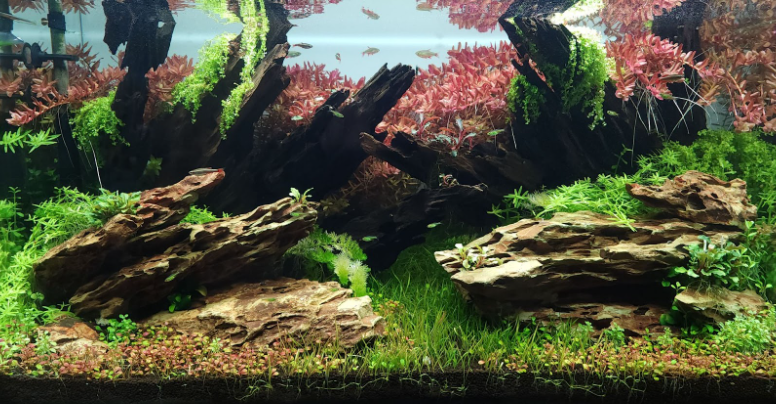 Diorama aquascape in our New Hope, PA location.
Diorama aquascape in our New Hope, PA location.
Laying the groundwork is crucial before you buy a piece of driftwood or drop a plant into your tank. Proper planning is the difference between a balanced, long-lasting aquascape and one that needs constant fixing. Below are six essential tips to help you plan your aquascape before purchasing.
quascaping journey with a clear vision. Collect photos of aquascapes you admire—whether it's a serene Iwagumi layout or a lush Nature Aquarium. Pinterest, Instagram, and aquascaping competitions like IAPLC are goldmines for ideas. Save 3 to 5 examples that reflect the style, mood, or layout you’d like to replicate.
Just as important: know the exact dimensions of your aquarium. Many beginners fall in love with a layout style that doesn’t suit their tank size or shape. Whether working with a 5-gallon nano or a 90P rimless display, matching your hardscape and planting strategy to your tank’s proportions will save you money and frustration.
Consistency is key in aquascaping. Mixing multiple rock types or combining different driftwoods (like Spider Wood and Madra Wood) can make your layout look disjointed or unnatural. Stick with one type of rock and one type of wood to maintain visual cohesion and create a believable environment.
For example, avoid adding Dragon Stone or other porous rocks using Seiryu Stone for a crisp Iwagumi layout. Similarly, if you've chosen Manzanita for its fine branches, skip chunkier woods that don’t match its aesthetic.
Believe it or not, your substrate can make or break your layout’s realism. If you’re using aquarium soil with a warm, red-brown tone, opt for a hardscape that complements it, like Maple Leaf stone or spider wood. On the other hand, a bright sand foreground pairs beautifully with pale woods or light-colored stones like Elephant Skin or Ryuoh Stone.
This visual harmony ties your space together and prevents your layout from feeling off-color. It's also worth noting that some rocks can alter water chemistry—always research how they interact with your chosen substrate and livestock.
Think of your workspace—a table, floor, or empty tank—as your aquascaping dojo. Most aquarium stores that supply aquascaping products will have a dedicated aquascaping dojo for you to design before you buy. Regardless of venue, arrange your hardscape outside the tank before committing to anything to test different layouts. This allows you to rotate, reposition, and swap out pieces without dealing with water, soil, or plants.
Photograph each iteration from the front to see how it reads visually. What looks great in your head often doesn’t quite translate to an excellent space or look great in a 2D photo. Treat this step as your creative playground to experiment and refine your vision.
When building your dream aquascape, it’s easy to get lost in aesthetics, but practicality matters. Make sure you leave open space for maintenance tools like algae scrapers, trimming scissors, and siphons. Avoid cramming plants or stones against all four glass panels; your future self will thank you during weekly water changes.
Think long-term: plant growth, fish waste, and algae will require regular attention. Design with accessibility and flow in mind so you can maintain your aquascape without disrupting its structure.
Once you’ve locked in your layout, take a photo of your final hardscape setup—this snapshot becomes your blueprint when it’s time to recreate it in the aquarium. Then, use masking tape to label and number each rock or wood piece, and take another photo. This step may sound tedious, but it prevents confusion during setup. A visual reference and a numbered guide help you rebuild your aquascape quickly and accurately. No more remembering “where that one cool rock was supposed to go.”
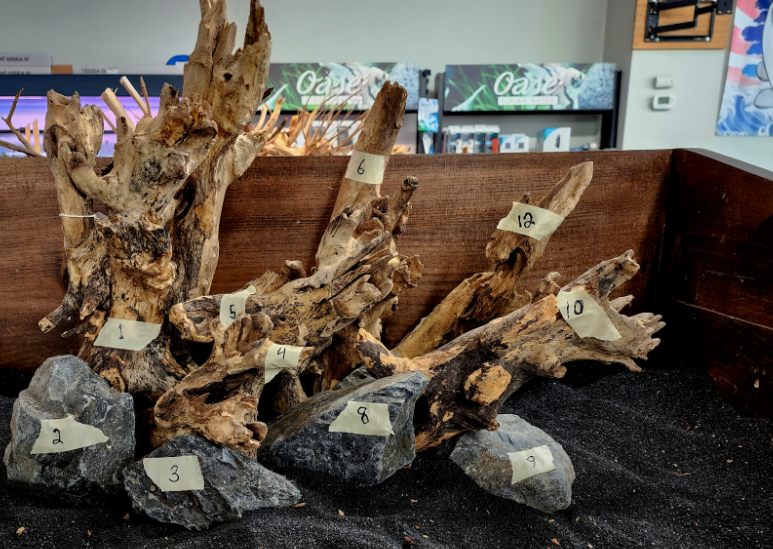 Here is a hardscape layout in our aquascaping dojo. Notice the numbered pieces to make reassembly easier.
Here is a hardscape layout in our aquascaping dojo. Notice the numbered pieces to make reassembly easier.
While setting up a beautiful aquascape, your aquarium's substrate or bottom layer is more than just an ornament. In aquascaping, substrate is not secondary, as it assists in growing plants, anchors the hardscape, and defines the contours of the layout. Every type of substrate, from nutrient-rich soils to crisp white sands, has its own purpose.
Aqua soil is the primary substrate used in most planted aquariums. Made from nutrient-rich clay-based materials, aqua soils such as ADA Aqua Soil Amazonia or Oase Scaperline Soil provide essential nutrients for root-feeding plants. They promote strong, healthy root systems and help maintain ideal water parameters by lowering pH and softening water conditions that most aquatic plants prefer.
In high-tech and Nature Aquarium-style aquascapes, aqua soil is considered non-negotiable. It supports lush carpeting plants like Monte Carlo, Glossostigma elatinoides, and Eleocharis, while offering long-term fertility that gravel or sand alone can’t match.
White or beige sands are usually used in Iwagumi or Brazilian-style layouts to accentuate the hardscape and increase the brightness of the aquascape. Remember, though, it’s best to put sand in places you do not wish to plant thickly, as it compacts over time and does not have enough nutrients for most rooted plants.
In Iwagumi and Brazilian styles, white or beige sand is often used to highlight the hardscape features and brighten the aquascape. Sand should only be added to places not heavily planted, as it compacts over time and generally lacks the nutrients required for most rooted plants.
In modern aquascapes, gravel serves mainly an aesthetic purpose. It is perfect for transitions between sand pathways and rock formations or for contrasting plants and hardscapes.
Fine gravel can also help anchor delicate root plants or serve as cover for bottom-dwelling species of fish, shrimp, or other macroinvertebrates. Some aquascapers create imitation forest or stream bed floors using gravel mixes. It’s best to use inert gravel that won't chemically alter the water, and washing it beforehand is also best.
A well-structured aquascape usually begins with a concealed underlayer made of porous materials like pumice or lava rock. These light rocks have many functions: They decrease the amount of expensive aqua soil needed, add elevation for steep slopes, and promote circulation through the substrate.
Porous lava stone is even more crucial in creating ideal conditions for the beneficial colonies, which aid the tank’s nitrogen cycle and enhance its water quality. This fill layer can prevent dead spaces from forming below the sediment, allowing plant roots better access to nutrients.
The best aquascapes often combine substrates to balance function and form. A typical layout might include:
By planning your substrate layers in advance, you can create a more natural-looking ad that will lay the groundwork for healthier plant growth and easier long-term maintenance.
Tips for Building a Hardscape
Having a hardscape in an aquascape is essential for any aquarium enthusiast. It enriches the layout, suggests where plants and fish will thrive, and sets the mood for the aquarium. Keeping soft scapes like stone and driftwood in mind, along with essential techniques, is instrumental in creating the ideal planted aquarium.
Tips for mastering the dos and don’ts of aquascaping hardscape have been suggested to aid you in becoming a professional immediately.
Blurring depth in aquascaping is an aspect that helps differentiate between a larger and a smaller aquarium. A handful of methods exist, such as using perspective to position smaller decor pieces towards the back while placing larger pieces at the forefront. This gives the tank a more natural feel, enabling a more immersive experience.
Using ledge outline space like sand to amplify the effect, coupled with forced perspective, works well. This is particularly useful for smaller tanks and diorama-style layouts.
When aquascaping, the ideal branch or rock isn’t prepackaged and ready to use. In most cases, the most breathtaking hardscapes are formed by using several components to create the illusion of one single piece. The beauty of nature often relies on the interplay between distinct parts, so go ahead and glue drifting wood branches together, stack stones, and tilt them to get the angle that gives the most satisfying balance to the arrangement.
If your inspiration photo features a dramatic arch or mountain formation, don’t stress if you can’t find a piece that matches it—you can build it using smaller components and clever assembly.
Driftwood often floats when first submerged, especially if it’s new or hasn’t been pre-soaked. This can ruin your layout and damage surrounding plants or glass. The solution? Anchor your wood to heavier stones at the base.
Use zip ties, stainless steel screws, or strong adhesives to secure the wood, then bury the stone base beneath the substrate for a clean look. Over time, the wood will become waterlogged and stay submerged, but anchoring it early keeps your scape stable.
When combining multiple hardscape pieces, you’ll need something stronger than gravity to hold them together. The more substantial solution? Super glue (cyanoacrylate) paired with a plant-based material like cotton or a paper towel. The glue quickly bonds to the hardscape and the fibrous material, creating a surprisingly strong, nearly invisible connection.
This method is aquarium-safe and widely used by professional aquascapers. Once submerged, the glue cures instantly, and the plant material helps bridge small gaps while forming a strong bond. To clean up any visible bonds, add a little super glue and crumble aqua soil over the top to mask the area.
If your layout includes elevated soil areas, especially next to clean sand zones, you’ll want to prevent any following from spilling into places it doesn’t belong. One clever trick is using a filter sponge or floss to plug gaps behind stones or wood. These soft, flexible, and water-permeable materials make them perfect barriers for keeping soil and sand layers cleanly separated.
This small detail can greatly improve the aesthetic clarity of your landscape, especially in tanks with contrasting substrate types like black soil and white sand.
While building a gorgeous hardscape, it is easy to forget the importance of practicality. Remember to design for maintenance—ensure adequate blank space for implements such as trimmers, algae scrapers, and siphons. Never obstruct access to filter intake points or spy vital regions obscured by massive clusters of rocks.
Also, consider trimming plants and gathering loose debris. If your design is too complicated, cleaning becomes a hassle, and the beauty of your aquascape may suffer with time.
One of the most interesting aspects of aquascaping is selecting and organizing the underwater plants to bring your design to life. However, planting is not only adding flora to a layout and covering blank or empty spaces. It also requires adding depth and contrast, along with a natural flow. The aquatic plants selected must be in sync with the design of your aquascape, the lighting, CO2 levels, and your skill level.
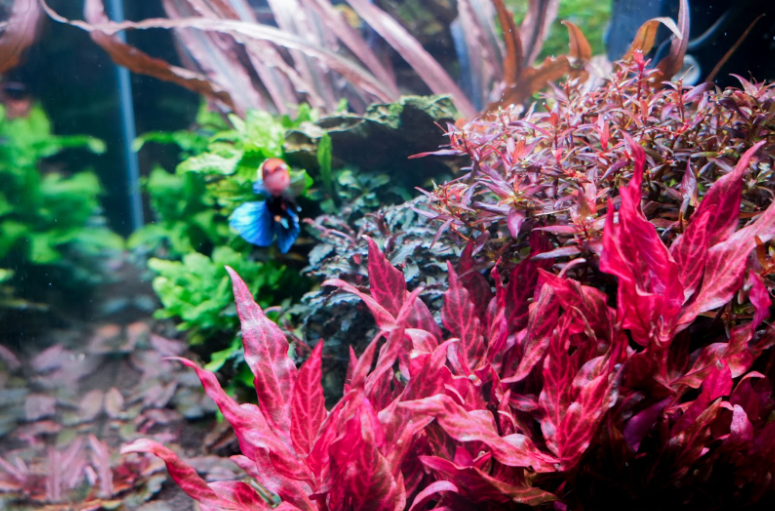 Aquatic plants come in many different shapes, sizes, and colors. How you choose and arrange your plants is important to the success of your aquascape.
Aquatic plants come in many different shapes, sizes, and colors. How you choose and arrange your plants is important to the success of your aquascape.
Unvital plants and aquatic plants differ in their care, and one of the most cited errors new aquascapers make is trying to affix plants to a tank environment that doesn’t suit them. If you have a low-tech tank that doesn’t use a CO2 injector or moderate lighting, stick to hardy species that can thrive in those conditions, such as Java Fern, Anubias, or Cryptocoryne.
If you're planning a high-energy tank with a Dutch or Nature aquarium, you will likely need a CO2 injector and strong lights to support more demanding species.
For example, red aquarium plants are said to be among the most demanding plants because they need a lot of light and CO2 to maintain their vibrant colors. They tend to fade to a dull green or wither without those conditions.
Such is the case with scrolling plants like Monte Carlo, Glossostigma, and Dwarf Baby Tears. Light and CO2 are obligatory if thick, lush carpets are desired. In the absence of these conditions, the plants will merely grow sparse tendrils—or remain dormant.
Tall-growing species positioned in rhomboid planter boxes create a feeling of flora and fauna scaling the entire tank. As such, all short, grass-like, or carpeting plants positioned in the foreground help elicit an open space; the focal point of the hardscape captures attention.
Popular options: Monte Carlo, Dwarf Hairgrass, Glossostigma elatinoides, Micro Sword.
Conditions: Carpet variants require high light and CO2, though some slower growers can work in low-tech setups.
The midground bridges the viewpoint with the lower striking plants and tall plants in the back. This layer is important because it fosters depth and flow, softens the transitions, and adapts the layout elements of the aquascaping.
Popular options: Cryptocoryne wendtii, Hygrophila pinnatifida, Lobelia cardinalis, Staurogyne repens.
Look for bushy or slightly taller species that offer alteration in textural patterns but do not block the view.
This is where the tallest plants in your layout go. Most of these serve as a frame for the aquascape. Some grow quickly, making a curtain or wall of plants beneath the tank.
Popular options: Ludwigia repens, Cyperus helferi, Vallisneria, Echinodorus, Rotala rotundifolia.
Some are fast-growing stems, while others, like swords and crypts, frame large rosettes in the background that anchor the design.
Pro Tip: To conceal equipment such as filters and heaters, put tall plants around the focal point to hide the equipment.
Epiphytes attach themselves to wood and stones instead of being planted in soil. They are one of the easiest plants to grow, making them ideal for beginners and people looking for low-maintenance aquascapes.
Popular options: Anubias, Java Fern, Bucephalandra, Christmas Moss.
No planting is necessary; they can be easily secured using glue, thread, or fishing line.
Without needing detailed maintenance or certain substrate types, epiphytes can bring a natural look and feel while adding variation in height and detail to the hardscape.
These freely floating plants sit on the water's surface and are best suited for low-flow tanks. They efficiently limit sunlight penetration, reducing algae growth and inhibiting access to unnecessary nutrients while providing shade.
These delicate roots can be damaged or pushed into corners in high-flow or high-tech tanks with surface agitation. Floating plants are beneficial in shrimp tanks, breeding setups, and low-light aquascapes where oversight aids in controlling algae.
After finishing your aquascaping layout, it’s time to add life to your design using aquatic plants. However, do not plunge unthinkingly into planting stems; wisely prepare the plants. Whether you have potted plants, bunched stems, carpeting species, or epiphytes such as Anubias or Java Fern, avoiding prep work ensures vigorous decay and a more complicated planting process.
Plant preparation is often overlooked, but it’s a key step in successful aquascaping. When done right, you avoid introducing dead matter into your tank, improve plant health, and set yourself up for easier planting.
Here’s how to prepare each plant type for your aquascape:
Pro tip: Lay your prepped plants on a sheet pan or shallow tray. This helps you keep everything organized during planting, and lets you mist them to keep them hydrated while you work.
Now that your plants are prepped, it's time to get your hands wet (literally). Here’s how to correctly plant them in the substrate to encourage strong rooting and healthy growth.
Some aquatic plants don’t go in the soil at all. Epiphytes and mosses thrive when attached to wood or stone, and they’re handy for adding texture and detail.
Important: Avoid gluing moss or epiphyte roots—it can block light and water, slowing their growth.
Behind every lush aquascape lies a balance of nature and technology. While the plants and hardscape might draw the eye, the unseen equipment makes the beauty possible. From crystal-clear water to vibrant reds and dense carpeting, your tank’s success depends on getting your lighting, filtration, and CO2 system just right.
A reliable aquarium filtration system is essential for any planted tank. In aquascaping, our main goals are to keep the water clear, maintain healthy flow, and support beneficial bacteria.
Unlike tanks with heavy bio-loads (like cichlid or goldfish tanks), aquascaping filters typically focus on mechanical and biological filtration—we don’t rely much on chemical media unless it's for specific water adjustments.
Here are the most common types of filters used in aquascaping:
Regardless of your setup, ensure your filter has enough flow to distribute nutrients evenly and prevent dead spots in your aquascape. Water circulation is essential in removing detritus from the plants and hardscape and ensuring that every corner of the tank is saturated with nutrients.
Not all lights are created equal when it comes to lighting for planted aquariums. Plants rely on consistent, high-quality light to photosynthesize, grow, and maintain vibrant coloration. Even the most meticulously planted scape will fall flat without the right spectrum and intensity.
Set your lights on a timer to provide 6–8 hours of consistent daily light. This mimics natural daylight cycles, ensures stability, and helps prevent algae growth caused by excess lighting.
At FFP, we’ve tested numerous brands and found the best results with WRGB LED lights. These full-spectrum lights deliver strong PAR levels (Photosynthetically Active Radiation), fueling growth and coloration in aquatic plants.
We recommend:
Pro tip: If you splurge on any part of your aquascaping setup, let it be the aquarium light. A high-quality light will last years, provide healthier plant growth, and make your aquascape pop with color.
CO2 (carbon dioxide) is one of the most powerful tools for transforming your planted tank. While small amounts of CO2 exist naturally in all well-aerated water, injecting CO2 into the water column dramatically improves aquatic plant growth, encourages dense carpeting, and enhances red coloration in demanding plant species. Without CO2, many high-tech aquascapes simply won’t thrive.
Setting up CO2 for your aquascape may seem intimidating, but it's no harder than installing an air pump. Here’s a more complicated breakdown of what you need for a basic pressurized system:
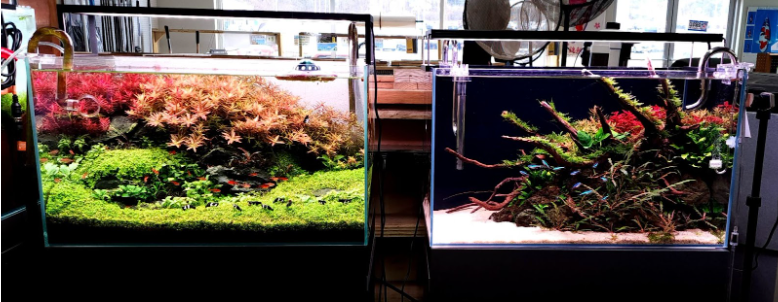 These high-tech aquariums in our Green Brook, NJ, location are balanced with regular maintenance and proper equipment.
These high-tech aquariums in our Green Brook, NJ, location are balanced with regular maintenance and proper equipment.
Maintaining an aquascape system is relatively easy and does not require hours of intricate detailing. The planted aquarium can be preserved in a beautiful, healthy equilibrium every week with just a few small steps.
Bringing equilibrium to an aquascape or a planted tank involves gentle water removal, ranging from 10 to 20% weekly. This gentle approach revolves water every week while keeping beneficial bacteria, waste, and excess nutrients untouched.
Remember to power off your filter and the heater to eliminate the chances of any damage. After the water has filled to a specific level, take the time to clean the glass while removing the floating plant debris using a fine-meshed net. If a clog lies within the filter, gently rinsing it with old tank water suffices. Maintaining a sound filtration system and all the aquarium's beneficial bacteria is essential.
After refilling the tank with dechlorinated water, add a water conditioner, remembering that it is dosed for the total tank volume, not just the replaced portion. Also, add beneficial bacteria to support the system and help your aquatic plants.
Correct trimming is important to the care and maintenance of your accessories, as it allows them to remain beautiful. The first step is cleaning the leaves and removing dead, decaying, or yellowing leaves. If left unattended, these will cause the water to contain high levels of nitrates and phosphates, which in turn will cause algae to bloom.
Stem-type plants such as Rotala or Ludwigia tend to outgrow their tallest height, so you should practice trimming them regularly. A good suggestion would be to cut below the node and replant the top section—this creates new growth. These cuttings will develop roots that help form new plants and fill your aquascape naturally.
Mariusz Sowiak suggests helping short carpeting plants like Pogostemon helferi and Monte Carlo dwarf baby tears remain under control. If they become too tall or thick, they might float off the substrate and ruin the aesthetics of your scape. With Anubias or Java Fern, for example, appropriate propagation is achieved by cutting the rhizome into smaller pieces, each bearing a few leaves. In contrast, moss must be trimmed regularly to prevent detaching from the hardscape. While trimming, moss cannot sink; siphon away the trimmings immediately.
Ensure that your plants have access to consistent nutrients so the growth remains lush and there is no nutrient deficiency. Nutrient imbalance must be avoided so your aquarium can grow vibrantly. Deploying micro-dosing, that is, daily or every other day, is a good approach. When teamed with an all-in-one liquid fertilizer, ‘micro-dosing’ gives the plants unrestrained access to nutrients and assures that algal feasting will be minimized.
Changing the water weekly will reset the overall nutrient levels and improve fertilization. Each time you change the water, make sure you put back the fertilizer. Using a liquid algae control enhancer like Seachem Excel or APT Fix is also a good idea. These products stop black beard and hair algae, two main issues in planted tanks. A daily dosage is recommended in tanks with high lighting or added CO2.
No matter how well-maintained the aquarium is, algae in aquascapes will remain an ever-present problem. Preventing the problem is much more effective than cleaning up after it. Altering the equilibrium of food in the tank is a prevalent cause of uncontrolled algae growth—overfeeding results in the breakdown of leftover food, which releases nutrients that feed algae and snails.
Preventing algae also requires keeping the tank clean of unwanted plant matter. As they die, plants release a lot of waste that algae can use. Improved cleaning procedures include soaking new plants in a potassium permanganate solution, which makes getting rid of algae spores, harmful bacteria, pests, and snail eggs easy.
Heavily planting the aquarium is one of the most effective and ecological ways to prevent algae growth. Well-maintained aquatic plants can soak up more light and nutrients, allowing algae to occupy little space.
As mentioned above, maintaining an aquascape system is most healthily done in a well-defined routine. Setting the light on a timer is great; 6 to 8 hours of light will support plant excellence and reduce the chances of algae growth due to predictability. Stick to a daily or bi-daily routine of fertilizer and algae inhibitor application. Make weekly water changes a routine.
These practices will not only improve the health of plants and clear the water but also create a low-stress, maintainable aquarium that is pleasing to the eye. With some attention taken weekly, the aquascape will be beautifully balanced for years to come.
After successfully planting and establishing your aquarium, the subsequent step is to bring in selected livestock to enhance movement and life. However, not every fish species will work well with an aquarium containing plants.
While Fitz’s Fish Ponds offers a full range of aquascape-friendly fish and invertebrates, knowing every species before putting them in your fish tank is still very important. Some fish can uproot plants, dig in the substrate, or get so big that they wreck your delicate design, which has taken so long to arrange carefully. You will want to avoid stocking these species in your aquascaped tank.
You have a few options for choosing livestock for a planted aquarium; as a rule, make sure they are small, calm, and plant-safe. Ideal candidates include schooling species like rasboras and danios, harlequin tetras, and corydoras catfish. They are small-sized, provide balance and movement to the tank, and are entirely harmless to the plants.
Freshwater ornamental shrimp, particularly cherry and amano shrimp, are another popular animal for planted tanks. They are entertaining to observe and help with algae and general tank cleaning.
If you're looking for a stunning showpiece for your aquarium, fish like betta splendens, angelfish for larger tanks, apistogrammas, and German blue rams are perfect due to their vibrant colors. However, these species have unique temperaments that require studying, so we highly recommend looking into that before purchasing tankmates.
Only introduce fish and shrimp to your aquarium after you are certain it is cycled, which will take around 4 to 6 weeks. Your plants should also be established and not easily uprooted, taking about 2 weeks after planting. If you don't want the hassle of testing your water using an aquarium test kit, take a water sample to any Fitz’s Fish Ponds retail location, as we offer this service for free! Once ammonia and nitrite levels reach near zero and nitrates are present, the tank is ready to introduce livestock.
The number of fish for a specific tank size is also essential. For best results, estimate the tank size by multiplying the number of fish in inches by 1 and the number of tank gallons in water by 10, considering the adult size, not the size at the store, which is the overrated common sizing technique. Using these methods allows for more straightforward computation and rough stocking limits.
Instead of segregating them by 1 or 2 fish and causing them distress and the tank with water quality issues, we suggest using the less tedious and stressful method of getting five to six fish, such as tetras or danios, which are optimal schooling fish.
To save time, quarantining fish before putting them in the main tank is usually avoided. Not taking the recommended vital steps to save fish breeds can introduce parasites or diseases, such as those seen in established tanks. Quarantining is especially helpful with hidden diseases that require time to reveal themselves and cause damage, so do it just in case.
Adding shrimps and otocinclus catfish might enhance the beauty of your tank, but little do you know they serve the vital purpose of an algae cleanup crew. This offsets the amano and nerite slugs, making them the holy trinity of natural algae management. For optimal outcomes, assuming every 10 gallons contains 1 active member of the holy trinity, a tad over one-5 otoconius is required to unleash their schooling power, making them comfortable amongst their healthy peers.
Integrating livestock at the correct time will complete your aquascape with movement, personality, and a balanced ecosystem. Remember: Take your time while researching; it will reward you with life and beauty.
Like many hobbies requiring some artistry, aquascaping requires a fair amount of equipment; while purchasing everything might seem pricey, it is generally an investment worth making. Central to the practice is, first and foremost, an aquarium tank and a sturdy stand. You will also need hardscape components such as rocks, wood, and substrates, like aqua soil, sand, or gravel.
To conserve water quality, you will require filtration systems, such as canister or sponge filters, and lighting like WRGB LED lights. If you want to get more technical, inject CO2 into the plants. Conditioners, fertilizers, and test kits help ensure good water quality and healthy plants. Do not add any livestock until your tank is fully cycled, and then add a variety of plant life, ranging from midground and background stem plants to foreground carpeting plants.
Fish keepers often debate the aquascaping divide between adhering strictly to the golden ratio as one principle or mounting the more free-spirited approach to employing organic shapes via the so-called “rule of thirds.”
Regardless of what unbelievable norms stratify aesthetic choices through your lens, balance takes precedence over any other technique when making choices within aquascaping and repurposing nature as a living piece of art.
Aquascaping is a process that consists of multiple steps:
Aquascaping is considered an art because it involves placing aquatic plants, rocks, wood, and other materials in an aquarium. An aquascaped aquarium should be visually stunning and balanced.
The aim should be to craft an aquarium that closely resembles natural underwater scenery, emphasizing the growth of aquatic vegetation and the beautiful arrangement of natural features while establishing a suitable environment for fish and other living organisms within the water.
You will need the following to start aquascaping:
Recommended species include the following:
Selecting a substrate involves satisfying the requirements of the plants you intend to keep and considering aesthetics. Aqua soil has plenty of gold and gives off the right nutrients, aiding plant growth, while sand and proper gravel could function as aesthetics or backdrops.
When selecting materials for the hardscape, focus on the materials used for the rest of your aquascape. If minimalism is the desired effect, smooth rocks and driftwood could be appropriate choices. Also, ensure the materials will not harm the aquarium or affect its parameters. Stay away from limestone and other materials known to change pH or hardness.
CO2 injection has great advantages, especially for high-tech aquaculture, as it makes plant growth more vigorous and improves color. For someone with a low-maintenance or low-tech setup, CO2 injection isn’t necessary.
Still, it will help deliver the best from the plants, especially if they are aimed at being carpet plants, which require high levels of CO2 to keep their color. CO2 injection is important to achieve a beautiful, dense carpet of foliage or stunning, vibrant red leaves.
An aquarium with plants requires maintenance such as changing the water (10-20% each week), cleaning the filter, removing excess algae and overgrown plants, and regular fertilization.
Additionally, monitoring water temperature, nutrients, pH level, and algae volume is essential. To improve the aesthetics, the preferred shape or trimming is required, as well as maintaining optimal growth. In any case, trimming foliage needs to be done to enhance the visual attractiveness of the aquascape and promote healthy development.
Equally important is to maintain the balance of algae, fertilizers, and growth inhibitors added to the ecosystem.
While digging and uprooting plants is common among numerous species of fish, some more peaceful species, such as tetras, rasboras, and shrimp, could coexist with an even more planted aquarium and improve its aesthetic and functioning. Invertebrates, along with fish, make any aquascaped tank more visually appealing. The togetherness of fish and plants is possible in an aquascaped tank.
Establishing a more mature aquascape takes approximately four to six weeks. A serene level in the number of water changes and maintenance will ensure the ecosystem reaches a more settled equilibrium. Completing the nitrogen cycle and achieving plant root stabilization mark the defining boundary of a more stable aquascape.
Eventually, once a robust baseline is established, an increase in plant growth accompanied by the level of maintenance provided over time will be visible. Regular testing of the water also supports the delicate balance.
Whether you're imagining a serene Iwagumi layout, a wild jungle-style scape, or a vibrant Brazilian showcase, the best time to begin is now. Aquascaping isn’t just a hobby—it’s an immersive way to express creativity, build balance, and create a living work of art that brings calm and inspiration to any space.
Don’t just admire aquascapes online—create your own. Look to Fitz’s Fish Ponds for expert advice, premium hardscape materials, healthy aquatic plants, and all the gear you need to build your underwater masterpiece.
Not sure where to start? Our team can guide you step-by-step, from layout design to lighting, filtration, and planting strategies tailored to your tank. Call us now at (908) 360-1755. Or visit one of our retail locations to explore everything you need to get started. Have questions? Our aquascaping experts are just a call or message away.
| Hours | |
|---|---|
| sunday | Closed |
| monday | Closed |
| tuesday | 10:00-5:00 |
| wednesday | 10:00-5:00 |
| thursday | 10:00-5:00 |
| friday | 10:00-5:00 |
| saturday | 10:00-5:00 |
| Hours | |
|---|---|
| sunday | 10:00-5:00 |
| monday | Closed |
| tuesday | 11:00-6:00 |
| wednesday | 11:00-6:00 |
| thursday | 11:00-6:00 |
| friday | 11:00-6:00 |
| saturday | 10:00-5:00 |
| Hours | |
|---|---|
| sunday | 10:00-4:00 |
| monday | Closed |
| tuesday | 10:00-5:00 |
| wednesday | 10:00-5:00 |
| thursday | 10:00-5:00 |
| friday | 10:00-5:00 |
| saturday | 10:00-5:00 |
| Hours | |
|---|---|
| sunday | 10:00-5:00 |
| monday | Closed |
| tuesday | 11:00-6:00 |
| wednesday | 11:00-6:00 |
| thursday | 11:00-6:00 |
| friday | 11:00-6:00 |
| saturday | 10:00-5:00 |
| Hours | |
|---|---|
| sunday | Closed |
| monday | 9:00-5:00 |
| tuesday | 9:00-5:00 |
| wednesday | 9:00-5:00 |
| thursday | 9:00-5:00 |
| friday | 9:00-5:00 |
| saturday | Closed |
| Hours | |
|---|---|
| sunday | 10:00-4:00 |
| monday | Closed |
| tuesday | 10:00-5:00 |
| wednesday | 10:00-5:00 |
| thursday | 10:00-5:00 |
| friday | 10:00-5:00 |
| saturday | 10:00-5:00 |
| Hours | |
|---|---|
| sunday | Closed |
| monday | Closed |
| tuesday | 10:00-5:00 |
| wednesday | 10:00-5:00 |
| thursday | 10:00-5:00 |
| friday | 10:00-5:00 |
| saturday | 10:00-5:00 |
| Hours | |
|---|---|
| Sunday | Closed |
| Monday | Closed |
| Tuesday | 10:00-5:00 |
| Wednesday | 10:00-5:00 |
| Thursday | 10:00-5:00 |
| Friday | 10:00-5:00 |
| Saturday | 10:00-5:00 |
| Hours | |
|---|---|
| Sunday | 10:00-4:00 |
| Monday | Closed |
| Tuesday | 10:00-5:00 |
| Wednesday | 10:00-5:00 |
| Thursday | 10:00-5:00 |
| Friday | 10:00-5:00 |
| Saturday | 10:00-5:00 |









| Hours | |
|---|---|
| sunday | Closed |
| monday | Closed |
| tuesday | 10:00-5:00 |
| wednesday | 10:00-5:00 |
| thursday | 10:00-5:00 |
| friday | 10:00-5:00 |
| saturday | 10:00-5:00 |
| Hours | |
|---|---|
| sunday | 10:00-5:00 |
| monday | Closed |
| tuesday | 11:00-6:00 |
| wednesday | 11:00-6:00 |
| thursday | 11:00-6:00 |
| friday | 11:00-6:00 |
| saturday | 10:00-5:00 |
| Hours | |
|---|---|
| sunday | 10:00-4:00 |
| monday | Closed |
| tuesday | 10:00-5:00 |
| wednesday | 10:00-5:00 |
| thursday | 10:00-5:00 |
| friday | 10:00-5:00 |
| saturday | 10:00-5:00 |
| Hours | |
|---|---|
| sunday | 10:00-5:00 |
| monday | Closed |
| tuesday | 11:00-6:00 |
| wednesday | 11:00-6:00 |
| thursday | 11:00-6:00 |
| friday | 11:00-6:00 |
| saturday | 10:00-5:00 |
| Hours | |
|---|---|
| sunday | Closed |
| monday | 9:00-5:00 |
| tuesday | 9:00-5:00 |
| wednesday | 9:00-5:00 |
| thursday | 9:00-5:00 |
| friday | 9:00-5:00 |
| saturday | Closed |
| Hours | |
|---|---|
| sunday | 10:00-4:00 |
| monday | Closed |
| tuesday | 10:00-5:00 |
| wednesday | 10:00-5:00 |
| thursday | 10:00-5:00 |
| friday | 10:00-5:00 |
| saturday | 10:00-5:00 |
| Hours | |
|---|---|
| sunday | Closed |
| monday | Closed |
| tuesday | 10:00-5:00 |
| wednesday | 10:00-5:00 |
| thursday | 10:00-5:00 |
| friday | 10:00-5:00 |
| saturday | 10:00-5:00 |
| Hours | |
|---|---|
| Sunday | Closed |
| Monday | Closed |
| Tuesday | 10:00-5:00 |
| Wednesday | 10:00-5:00 |
| Thursday | 10:00-5:00 |
| Friday | 10:00-5:00 |
| Saturday | 10:00-5:00 |
| Hours | |
|---|---|
| Sunday | 10:00-4:00 |
| Monday | Closed |
| Tuesday | 10:00-5:00 |
| Wednesday | 10:00-5:00 |
| Thursday | 10:00-5:00 |
| Friday | 10:00-5:00 |
| Saturday | 10:00-5:00 |
